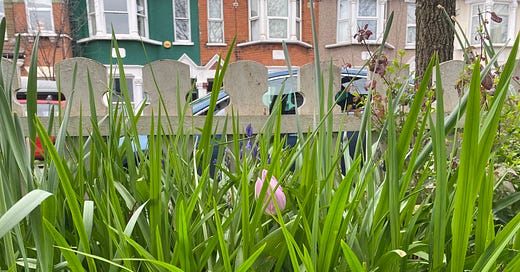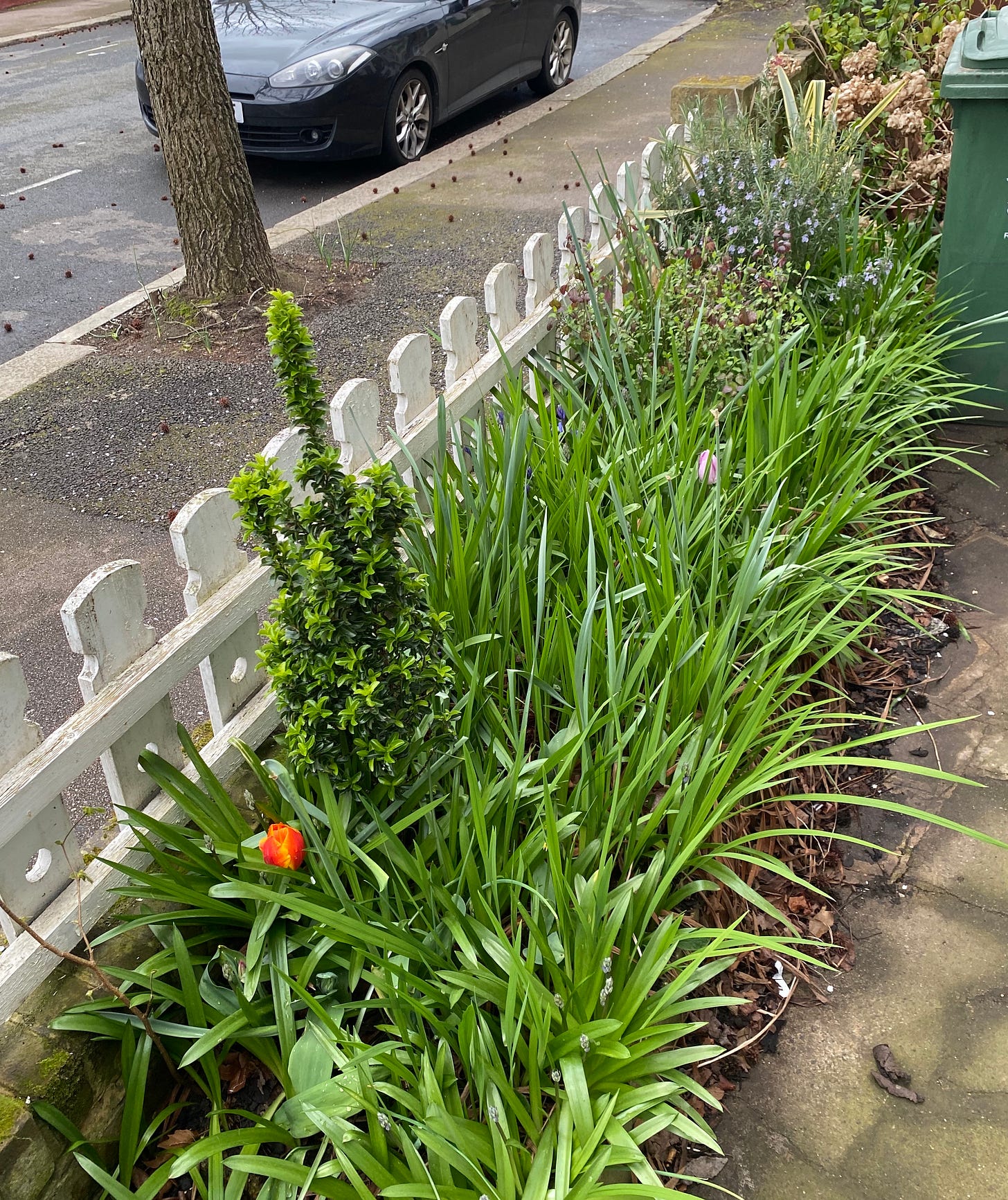Stumpy tulips, super-powered plant food, and lots of links
Introducing The Green Agenda, a new regular series of recommendations, insights and notes from my garden shed and beyond
You’re reading The Earthworm, a newsletter that takes a sideways look at the world of gardens, gardening, horticulture and all that good green stuff. If this is your first time here, you can catch up on anything you’ve missed by following this link. Subscribe now for free and join the community! You can also support me and my work on The Earthworm by upgrading to a paid subscription at any time – just tap the button below.
Sunny spells, late frosts, April showers. Ah yes, the English spring is upon us. And with this new season, I’ve decided to introduce a new regular series.
The Green Agenda is a space for observations and recommendations. Books and blogs; tools and tweets; podcasts and pot plants; things, in short, that I have enjoyed in the past week or two, and reckon you might too.
As ever, I don’t just welcome your comments, I crave them. Let me know what you make of The Green Agenda, and what you’d like to see in posts like this in future.
What I’ve noticed: stumpy tulips
I’ve lost count of the number of bulbs that I planted back in late November and early December, let alone how many veterans of autumn plantings past are already in the borders. Suffice to say: lots. We’re talking hundreds.
I’ve been enjoying the daffodils. No sign of the alliums or irises just yet, but it’s still early spring days. It’s the tulips though that have had me scratching my head. I deliberately double-checked that the varieties I was purchasing had some decent height to them. In the “front garden” (which sounds grand, but is barely wide enough to house our wheelie bins), I wanted the flowers to be visible above the less-than-idyllic white picket fence. Out back, I wanted to enjoy big and bountiful blooms, and create a spring display of splodgy kaleidoscopic colour.
What I actually have is a handful of stumpy little tulips, their elegant flowers barely discernible among the naturalised (read: unwanted) Spanish bluebell foliage that dominates the borders at this time of year. So, what gives? Did I buy dud tulips? Did I do something wrong, as per usual? The answer, it appears, is a dry one.
According to this Guardian article by Jane Perrone, tulips are most in need of a good drenching in the month or so before they flower. Now, it may be raining as I write this post, or indeed as you read it, but off the back of what has been a dry old winter, that’s too little too late for the tulips which are currently in flower. So, if you too have short and stout tulips this year, it’s not (entirely) your fault. Just be sure to keep your yet-to-flower tulips – especially those in pots – well watered over the coming weeks.
Where I’ve been: Rochfords plant nursery
I was lucky enough to join a guided tour of Rochfords a few days ago, a 70-acre nursery split over two sites, on the outskirts of Hertford. Chances are, you haven’t been, and won’t ever go, as Rochfords is a wholesale cash & carry, selling only to “landscape and garden professionals”.
I wasn’t there to buy plants, but to get an insight into how a business operates on the scale of Rochfords – we’re talking annual plant sales around the million mark. That’s just plants, not pounds.
Rows and rows of plants stretch out in every direction, arranged in broad categories, then clustered by species and cultivar. In a fledgling forest, wispy trees flower patiently in their pots as they await their final resting place. Across the site, the prominence of various plants reflects broader trends: conifers are few and far between, whereas meadows of ornamental grasses swish breezily in hues of green and gold. The site is so big – as are the orders being collected – that customers are encouraged to eschew trolleys, and instead drive around in their vans, loading in purchases as they go.
Rochfords doesn’t actually do much propagation (ie growing new plants), but sources plugs and young plants and grows these on, before selling eventually to landscapers, garden designers, small garden centres, councils, developers, etc. Traditionally, a lot of these plants were sourced from the Netherlands – Rochfords could put an order in for 2,000 plants on a Monday, and be unpacking the crates by lunchtime on Tuesday.
Well, these days, those supply chains are in trouble. Every single consignment of plants entering the UK (from Europe or anywhere else) now needs an accompanying phytosanitary certificate. That comes at a cost, which must be absorbed by the purchaser. Then there are rising transportation costs – owing both to the soaring price of oil and recent levies on the heavily polluting shipping industry. And finally there are the border checks in the UK, which can hold a consignment up for hours, if not days.
As our Rochfords guide pointed out, a few hours’ delay on a hot day and you’ve lost thousands of pounds’ worth of plants. And so, sadly, many European suppliers have cut long-standing ties with their British partners. Many others have jacked up their prices. It’s a troubling time for British nurseries, not to mention the sky-high price of fertiliser due to the ongoing humanitarian nightmare in Ukraine.

On a more positive note, it was heartening to see the steps being taken towards a more sustainable approach to industrial-scale plant growing. You know those black plastic pots that your plants come in at the garden centre or local nursery? Well, the vast majority of councils can’t or won’t recycle these, as the black colouring isn’t visible to the machines that sort the recycling. Ergo: they end up in landfill.
At Rochfords they have started using grey pots which not only use 50% less plastic in their manufacture, but can actually be recycled. They’re also experimenting with various peat alternatives, to try to eliminate peat-based compost from their production line as quickly as they can. (They’ve made laudable progress, but there’s still plenty of work to be done here.)

What I’ve heard: Growing Greener with Arit Anderson
I’ve been really enjoying this new podcast series from BBC Gardeners’ World magazine, hosted by TV garden designer Arit Anderson. The focus is on sustainability – hence “growing greener” – and each episode is a conversation between Arit and an expert on some aspect or other of sustainable gardening practices. Water-wise gardening, for example, and landscaping materials.
Episode 1, in which she talks with Professor Tim Lang about soil health and organic food production, is a particular highlight. Professor Lang’s facts and stats about our agricultural land use – which in Britain is basically all just grassland for grazing cows and sheep – are startling and sobering, especially given the global food crisis that we are plunging into apace.
What I’ve harvested: Worm wee
I have a wormery. It is amazing. I put food scraps and old newspaper in, and the worms work their magic to provide me with nutrient-dense poo to feed my soil, and wee to feed my plants.
The worms – which are specialist composters and not the same as the ones you’ll find in your beds and borders – slow right down over winter, and are far less “productive” than they are when the weather gets warmer. As such, I deliberately hadn’t drained their plant-food receptacle (yes, urinal) for weeks.
When I finally did, I was rewarded with three litres’ worth of liquid gold, which I’ll be diluting with water and feeding to my favourite plants over the coming weeks. (I might wait a bit before I do though, until the risk of frost has reduced and the plants are in full-growth-ahead mode – to avoid them shooting up only to get cut down again by a late cold snap.)
What I’ve read: 3 more gardening-based Substacks
- ‘The trendiest plant in my garden’ on Rootbound, where Boaz Frankel talks about living life on the sedge.
- ‘Borders #2’ on The Gardening Mind, where Jo Thompson shares a step-by-step border design masterclass… with sketches!
- ‘"Patiently" waiting for spring’ on The Marginal Garden, where The Marginal Gardener invites us into their new home in Indiana, following many years of living and gardening in the UK.
Did you enjoy the inaugural Green Agenda? Has your tulips’ growth been stunted? Do you keep worms? Have you got any favourite garden-based podcasts? Do you have any recommendations or observations to share with the wider The Earthworm community? Please, be my guest.










I'm also massively interested in the wormery. What does it look like? What's special about the worms (over normal garden worms)? How do you know if you're over feeding them (before they die)? How many worms do you need? Do they procreate? I'd love to read more about it in a future post : )
Where do you position your wormery, Dan? Is it OK outside in winter or is it in a shed or something?